Reusable Foodservice Packaging Market Size
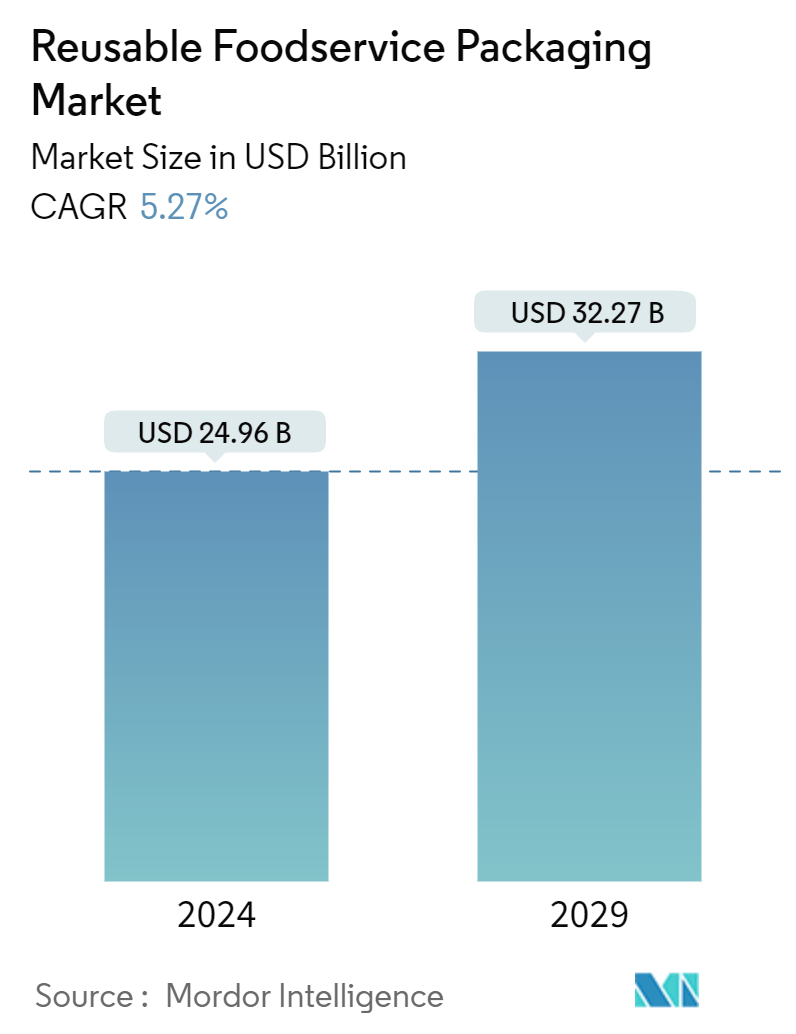
| Study Period | 2019 - 2029 |
| Market Size (2024) | USD 24.96 Billion |
| Market Size (2029) | USD 32.27 Billion |
| CAGR (2024 - 2029) | 5.27 % |
| Fastest Growing Market | Asia Pacific |
| Largest Market | Asia Pacific |
Major Players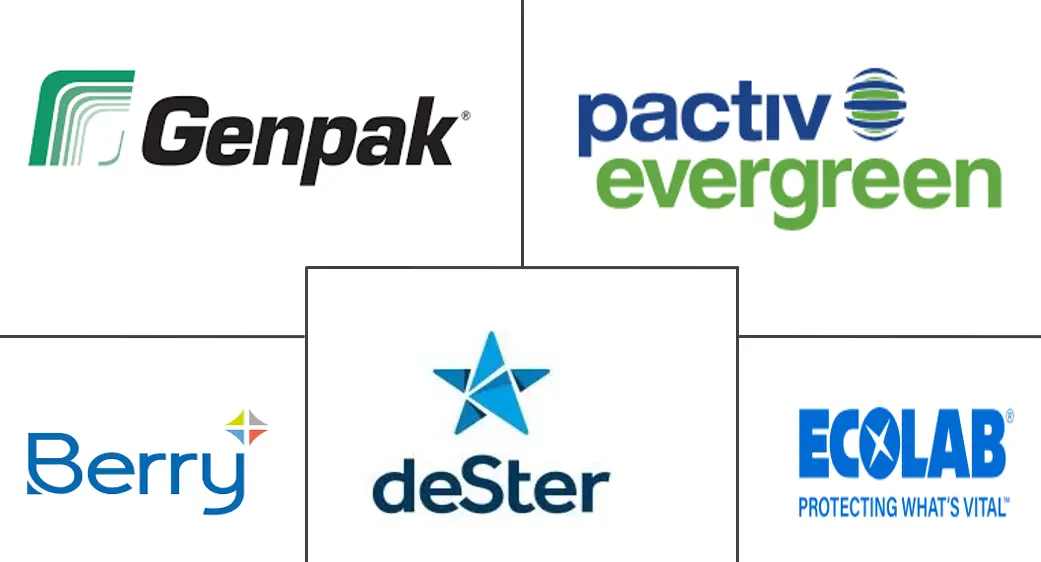
*Disclaimer: Major Players sorted in no particular order |
Reusable Foodservice Packaging Market Analysis
The Reusable Foodservice Packaging Market size is estimated at USD 24.96 billion in 2024, and is expected to reach USD 32.27 billion by 2029, growing at a CAGR of 5.27% during the forecast period (2024-2029).
The global reusable packaging market is set for significant growth, fueled by a rising need for durable and sustainable material handling solutions. Returnable packaging stands out for its pivotal role in sustainability, curbing the volume of packaging waste that typically ends up in landfills.
- A diverse urban landscape drives the country's demand for convenient, on-the-go, lightweight foods. In recent years, ready-to-eat and convenient food has evolved into one of the most diverse segments of the global food service, with rising concern about the environment and the escalation in packaging landfills, reusable food service packaging in hotels, full-service restaurants (FSRs), and quick-service restaurants (QSRs).
- Several government bodies worldwide impose strict guidelines for using reusable packaging across sectors. For instance, the SUP Directive mandates that EU Member States actively reduce single-use plastic waste, setting specific reduction targets at local and national levels. In tandem with restrictions, these states are advocating for reusable food packaging to achieve these goals.
- In France, recent legislation mandates that all on-site meals or snacks be consumed using reusable packaging or crockery.
- Over the past few years, the online food ordering and restaurant delivery sector has grown by 20%. As the online food delivery system gains traction, there is a corresponding surge in demand for sustainable food service packaging. As per the China Internet Network Information Center publication in March 2024, the number of online food delivery users in China rose from 418.83 million in 2020 to a whopping 544.54 million in 2023. This uptick is prompting manufacturers to pivot toward eco-friendly reusable packaging solutions.
- However, transitioning from a single-use to a reuse model for plastic packaging in industrial food applications can introduce unforeseen challenges, particularly in hygiene and sensory perception. Reusing plastic packaging carries the risk of heightening chemical contamination and the presence of microplastic particles in food products. Additionally, it may compromise the packaged goods' hygienic standards and sensory consistency.
- Globally, large companies are shifting from the traditional 'catch, fill, and waste' model to a zero-waste lifestyle. They achieve this by making foodservice packaging reusable, thus extending its lifecycle sustainably. This shift not only cuts down on operational costs tied to packaging but also eliminates the need for continual new packaging purchases.
Reusable Foodservice Packaging Market Trends
Growing Demand From Quick-service Restaurants (QSR) Aids the Market
- Quick-service restaurants (QSRs) offer low-cost food options, focusing on speed of service. Minimal table service and an emphasis on self-service distinguish this group from traditional restaurants. Food and beverages are paid for before consumption at QSRs. Over the last decade, the regional foodservice market, specifically for these countries, has witnessed the growth of several international QSR chains and home-grown brands offering varied cuisines suiting changing consumer preferences.
- With rising awareness of environmental sustainability, several major QSR chains are increasingly focusing on recyclability, compostability, and reusable packaging. Notable players, including Burger King, McDonald's, and Wendy's, have pledged to adopt reusable packaging.
- For instance, McDonald’s in France offers 21 reusable containers for dine-in customers. These include red plastic containers for fries, clear plastic beverage glasses, and white plastic cups designed for chicken nuggets.
- The franchise model will be crucial to the rise of QSR chains, which is expected to fuel market growth across the globe in the upcoming period. According to the data published by the International Franchise Association, in April 2024, after a slight downfall during the COVID-19 pandemic, the number of QSR in the United States rose steadily in the past few years from 183.54 thousand in 2020 to 195.51 thousand in 2023. Notably, as per the estimates, the number of QSRs across the country is expected to further improve during the forecast period.
- Further, increased spending on food, driven by a rising preference for on-the-go eating, has bolstered the demand for QSRs, fueling the need for reusable food service packaging. As per the Office for National Statistics (United Kingdom), consumer spending on restaurants and cafes in the United Kingdom skyrocketed in the post-pandemic period to GBP 132.89 billion (USD 169.50 billion). This bolstered spending is expected to consequently impact the market positively.
- Presently, millennials and Gen Z, in particular, actively seek out brands and places that resonate with their core values. Overall, QSRs can align with consumer demands for transparency and authenticity by actively showcasing their values. This can be achieved through initiatives like fundraisers and promotions, which feature sustainably sourced ingredients and recyclable and reusable packaging.
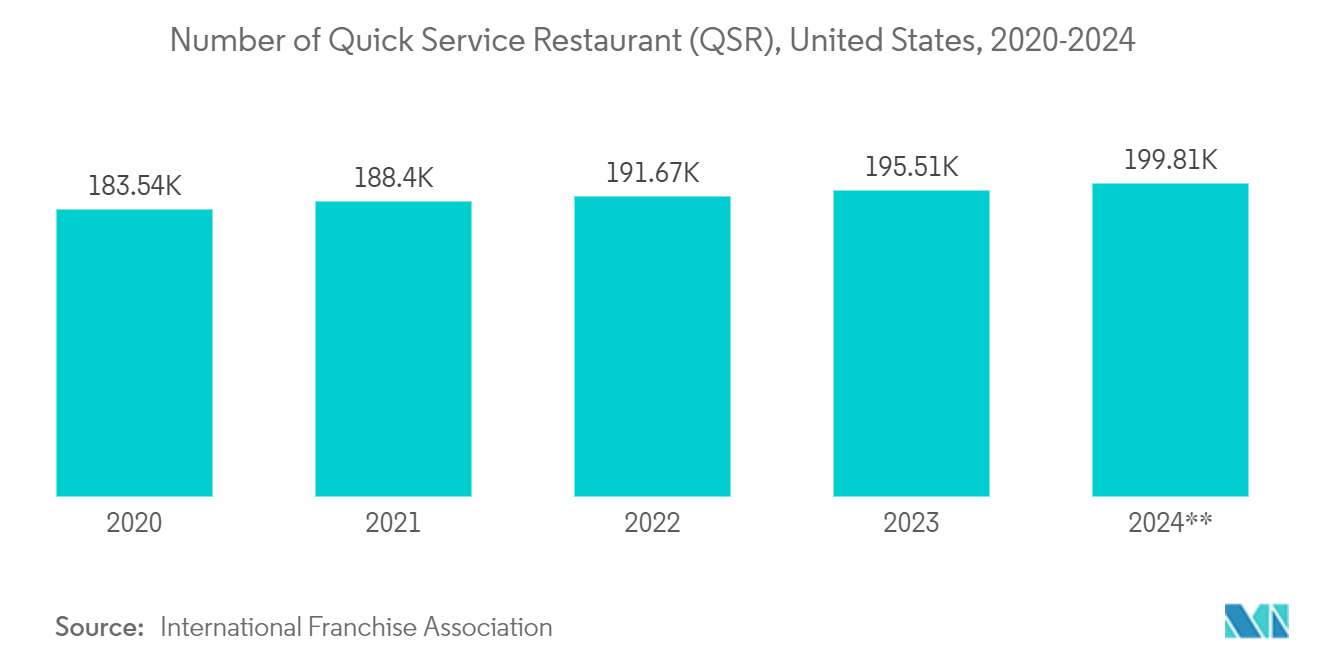
Asia-Pacific is Expected to Hold a Significant Market Share During the Forecast Period
- Asia-Pacific is home to densely populated and emerging economies such as China and India, and the demand for food services is surging. The market is propelled by a surge in demand for convenience, a pivot toward healthier dietary choices, and consequently, a notable uptick in adopting sustainable packaging is projected to peak during the forecast period. These trends transform the region into a technological innovation and business growth center.
- The region is witnessing a rapid surge in the demand for mobile food service stations. This uptick is primarily driven by escalating urbanization, increasingly busy lifestyles, and a heightened appetite for on-the-go dining.
- For instance, in June 2023, a Hong Kong student-led food service start-up introduced an eco-friendly rental service for reusable bowls. Eleven restaurants with 300 registered users have joined this innovative initiative. Such regional developments would bolster the awareness of reusable product packaging in the foodservice sector.
- The surge in plastic pollution in Asia-Pacific has prompted governments across the region to implement policies that aim to reduce plastic waste and promote sustainable packaging solutions. In 2022, the Government of India introduced a ban on single-use plastic in several sectors, including food service, thereby accelerating the demand for multiple-use packaging products across the country.
- Further, with the growing working population and busy lifestyles, consumer spending on eating outside is also increasing in countries like Japan, China, India, and Indonesia. For instance, according to the Ministry of Internal Affairs and Communications (Japan) and Statistics Bureau of Japan's report published in February 2024, the annual average household expenditure on dining out in Japan increased rapidly from JPY 8.11 thousand (USD 0.051 thousand) in 2021 to JPY 11.11 (USD 0.070 thousand) in just three years ending 2023.
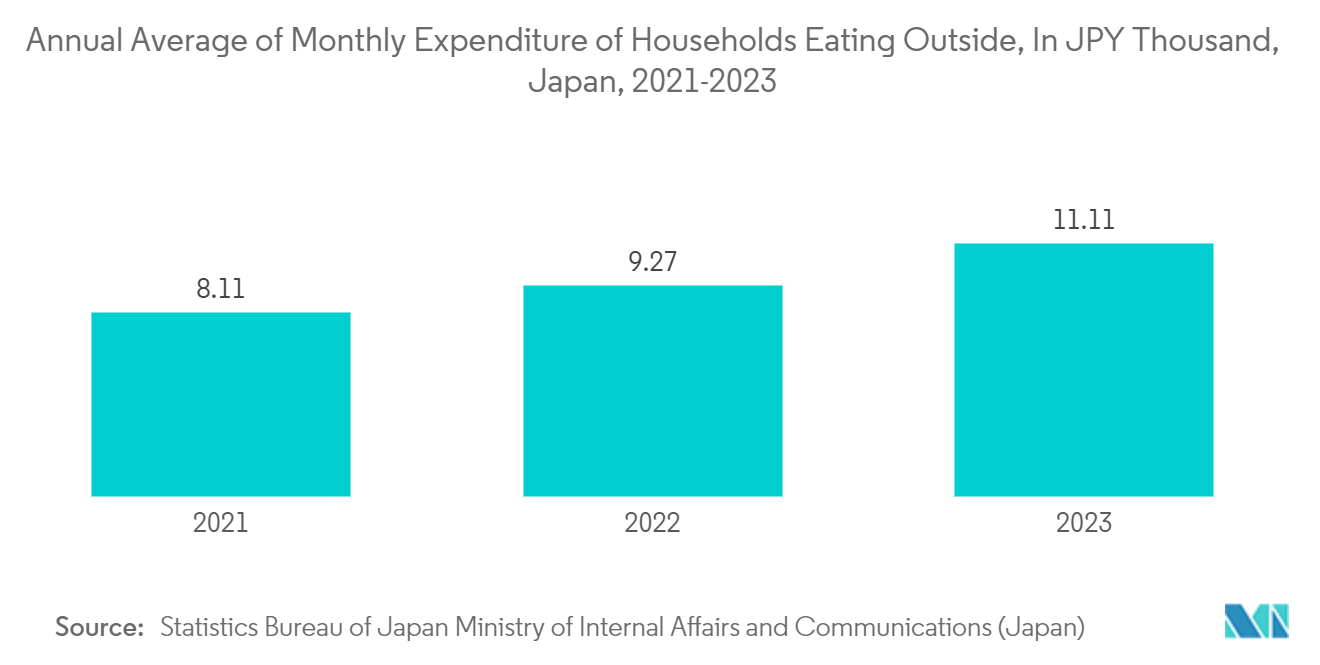
Reusable Foodservice Packaging Industry Overview
The market studied is fragmented, with major vendors accounting for most of the market share. The presence of many players in the market impacts the pricing of services, making it a direct competing factor, especially for small-scale vendors. The vendors in the market studied are expected to focus on providing one-stop-shop services, giving them a competitive advantage. Some of the major players in the market are Berry Global Inc., Ecolab Services, Genpak LLC, and Enpak Enterprise Co. Ltd.
- February 2024: Berry Global launched its Reusable Tableware Range to address the incremental demand for sustainable packaging across the food service industry. This move comes as legislation and consumer demands push the sector towards more eco-friendly packaging solutions. According to the company's Vice President of Food Service division, the new range of reusable tableware aims to cut waste, lessen reliance on new resources, and ensure functionality and durability while meeting legislative standards.
- May 2024: deSter, a developer of serviceware and food packaging, and Eastman, a specialty materials company, collaborated to introduce reusable in-flight drinkware to the airline sector. The packaging utilizes Tritan Renew, a specialty plastic crafted from recycled molecular copolyester. During its development, plastic waste is broken down into its fundamental chemical components, enabling the material to undergo multiple recycling cycles.
Reusable Foodservice Packaging Market Leaders
-
Berry Global Inc.
-
Ecolab services
-
deSter Corporation
-
Pactiv Evergreen Inc.
-
Genpak LLC
*Disclaimer: Major Players sorted in no particular order
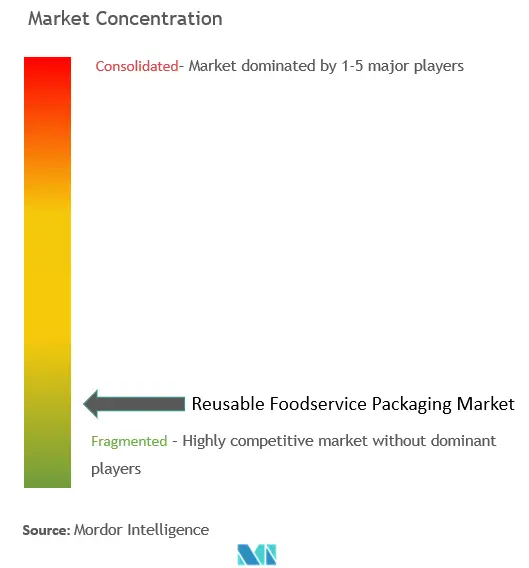
Reusable Foodservice Packaging Market News
- October 2023: Berry Global, a key player in reusable packaging in the foodservice sector, introduced a new line of premium reusable plastic cups, catering to the rising demand for sustainable alternatives to single-use packaging. The new drinking cups offer exceptional durability and exude a reusable quality. They are dishwasher-safe, featuring an inside stacking rim and ribs with smooth curves, enhancing their cleaning efficiency.
- September 2023: A New York City-based foodservice subscription program for office workers, MealPal, introduced the launch of a reusable container program. The company plans to introduce its reusable technology to hundreds of its restaurant partners in New York City. As sustainability gains momentum, customers can opt for reusable containers when placing orders via the app. At the restaurant, they scan a unique QR code to confirm the return.
Reusable Foodservice Packaging Market Report - Table of Contents
1. INTRODUCTION
- 1.1 Study Assumptions and Market Definition
- 1.2 Scope of the Study
2. RESEARCH METHODOLOGY
3. EXECUTIVE SUMMARY
4. MARKET INSIGHTS
- 4.1 Market Overview
-
4.2 Industry Attractiveness - Porter's Five Forces Analysis
- 4.2.1 Bargaining Power of Suppliers
- 4.2.2 Bargaining Power of Buyers
- 4.2.3 Threat of Substitutes
- 4.2.4 Threat of New Entrants
- 4.2.5 Intensity of Competitive Rivalry
- 4.3 Industry Value Chain Analysis
- 4.4 Assessment of Impact of Recent Geopolitical Scenario on the Industry
- 4.5 Reusable vs Single-user Safer Solution in Current Scenario
5. MARKET DYNAMICS
-
5.1 Market Drivers
- 5.1.1 Growing Demand In Online Food Delivery Service
- 5.1.2 Incremental Awareness For Environmental Sustainability and Stringent Regulations Against Single-Use Plastic Packaging
-
5.2 Market Restraints
- 5.2.1 Unforeseen Consequences of Reusing Plastic Packaging and Health Related Concerns
6. MARKET SEGMENTATION
-
6.1 By Material Type
- 6.1.1 Metal
- 6.1.2 Plastic
- 6.1.3 Glass
- 6.1.4 Other Material Types
-
6.2 By Product Type
- 6.2.1 Corrugated Boxes And Cartons
- 6.2.2 Bottles and Glasses
- 6.2.3 Trays, Plates, Food Containers, and Bowls
- 6.2.4 Cups And Lids
- 6.2.5 Clamshells
- 6.2.6 Other Product Types
-
6.3 By End-user Industry
- 6.3.1 Quick-service Restaurants (QSR)
- 6.3.2 Full-service Restaurants (FSR)
- 6.3.3 Institutional
- 6.3.4 Hospitality
- 6.3.5 Other End-user Industries
-
6.4 By Geography***
- 6.4.1 North America
- 6.4.1.1 United States
- 6.4.1.2 Canada
- 6.4.2 Europe
- 6.4.2.1 United Kingdom
- 6.4.2.2 Germany
- 6.4.2.3 France
- 6.4.2.4 Italy
- 6.4.2.5 Spain
- 6.4.3 Asia-Pacific
- 6.4.3.1 China
- 6.4.3.2 Japan
- 6.4.3.3 India
- 6.4.3.4 Australia and New Zealand
- 6.4.4 Latin America
- 6.4.4.1 Brazil
- 6.4.4.2 Argentina
- 6.4.4.3 Mexico
- 6.4.5 Middle East and Africa
- 6.4.5.1 Saudi Arabia
- 6.4.5.2 United Arab Emirates
- 6.4.5.3 South Africa
7. COMPETITIVE LANDSCAPE
-
7.1 Company Profiles
- 7.1.1 Berry Global Inc.
- 7.1.2 Ecolab services
- 7.1.3 deSter Corporation
- 7.1.4 Genpak LLC
- 7.1.5 Pactiv Evergreen Inc.
- 7.1.6 Limepack
- 7.1.7 Re:Dish Co.
- 7.1.8 Verive
- 7.1.9 Evergreen Packaging
- 7.1.10 Enpak Enterprise Co. Ltd
- *List Not Exhaustive
8. INVESTMENT ANALYSIS
9. MARKET OPPORTUNITIES AND FUTURE TRENDS
** Subject To AvailablityReusable Foodservice Packaging Industry Segmentation
Reusable packaging denotes containers and packaging materials crafted for multiple uses. This approach not only curtails waste but also offers a circular economy. Such solutions, known for their durability and efficiency, present an eco-friendly and sustainable substitute for conventional single-use packaging. Based on current trends and market dynamics, the study tracks and analyzes the demand for reusable packaging within the food service industry. The market numbers are derived by tracking the revenue generated by players providing reusable packaging products across the end-user industries. The study provides a detailed breakdown of the various types of material across different geographies.
The reusable foodservice market is segmented by material type (metal, plastic, glass, and other material types), product type (corrugated boxes and cartons, bottles and glasses, trays, plates, food containers, and bowls, cups and lids, clamshells, and other product types), end-user industry (quick-service restaurants {QSR}, full-service restaurants {FSR}, institutional, hospitality, and other end-user industries), geography (North America {United States, Canada}, Europe {United Kingdom, Germany, France, Italy, Spain, and Rest of Europe}, Asia-Pacific {China, India, Japan, Australia and New Zealand, and Rest of Asia-Pacific}, Latin America {Brazil, Mexico, Argentina, and Rest of Latin America}, Middle East and Africa {United Arab Emirates, Saudi Arabia, South Africa, and Rest of Middle East and Africa}). The report offers market sizes and forecasts in value (USD) for all the above segments.
| By Material Type | Metal | |
| Plastic | ||
| Glass | ||
| Other Material Types | ||
| By Product Type | Corrugated Boxes And Cartons | |
| Bottles and Glasses | ||
| Trays, Plates, Food Containers, and Bowls | ||
| Cups And Lids | ||
| Clamshells | ||
| Other Product Types | ||
| By End-user Industry | Quick-service Restaurants (QSR) | |
| Full-service Restaurants (FSR) | ||
| Institutional | ||
| Hospitality | ||
| Other End-user Industries | ||
| By Geography*** | North America | United States |
| Canada | ||
| By Geography*** | Europe | United Kingdom |
| Germany | ||
| France | ||
| Italy | ||
| Spain | ||
| By Geography*** | Asia-Pacific | China |
| Japan | ||
| India | ||
| Australia and New Zealand | ||
| By Geography*** | Latin America | Brazil |
| Argentina | ||
| Mexico | ||
| By Geography*** | Middle East and Africa | Saudi Arabia |
| United Arab Emirates | ||
| South Africa |
Reusable Foodservice Packaging Market Research FAQs
How big is the Reusable Foodservice Packaging Market?
The Reusable Foodservice Packaging Market size is expected to reach USD 24.96 billion in 2024 and grow at a CAGR of 5.27% to reach USD 32.27 billion by 2029.
What is the current Reusable Foodservice Packaging Market size?
In 2024, the Reusable Foodservice Packaging Market size is expected to reach USD 24.96 billion.
Who are the key players in Reusable Foodservice Packaging Market?
Berry Global Inc., Ecolab services, deSter Corporation, Pactiv Evergreen Inc. and Genpak LLC are the major companies operating in the Reusable Foodservice Packaging Market.
Which is the fastest growing region in Reusable Foodservice Packaging Market?
Asia Pacific is estimated to grow at the highest CAGR over the forecast period (2024-2029).
Which region has the biggest share in Reusable Foodservice Packaging Market?
In 2024, the Asia Pacific accounts for the largest market share in Reusable Foodservice Packaging Market.
What years does this Reusable Foodservice Packaging Market cover, and what was the market size in 2023?
In 2023, the Reusable Foodservice Packaging Market size was estimated at USD 23.64 billion. The report covers the Reusable Foodservice Packaging Market historical market size for years: 2019, 2020, 2021, 2022 and 2023. The report also forecasts the Reusable Foodservice Packaging Market size for years: 2024, 2025, 2026, 2027, 2028 and 2029.
Reusable Foodservice Packaging Industry Report
Statistics for the 2024 Reusable Foodservice Packaging market share, size and revenue growth rate, created by Mordor Intelligence™ Industry Reports. Reusable Foodservice Packaging analysis includes a market forecast outlook for 2024 to 2029 and historical overview. Get a sample of this industry analysis as a free report PDF download.



